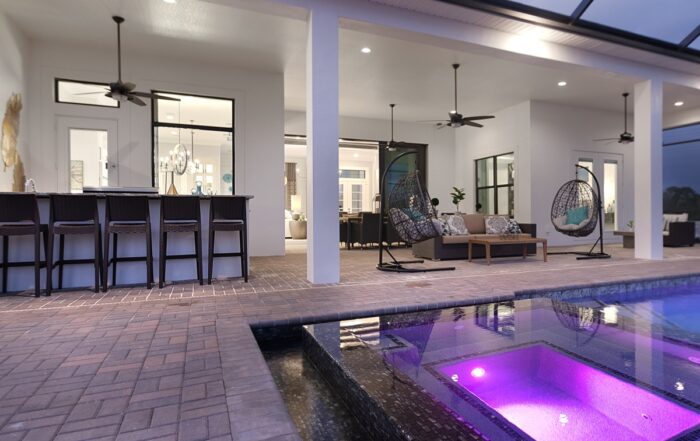
Open-concept floor plans are the most popular and requested layout choice among homeowners. As people become busier, these blended floorplans allow families to experience unity while engaging in different activities such as watching TV and cooking. Television networks like HGTV and DIY, broadcast design show hosts sledgehammering walls to achieve larger living spaces. But what defines an open-concept floorplan, and is it ideal for your home?
What is an open-concept floorplan?
Open-concept floorplans embody modern living. Historically, when building a home, each room served a different purpose. Rooms were often formal, and kitchens were usually enclosed. Surprisingly in the 1950s, it was still taboo for guests to be exposed to kitchen areas.
As time progressed, architects and homebuilders noticed that space could be maximized through open floor plans. The needs of families also evolved with time; defined living areas were no longer deemed necessary. As urban living increased, family homes decreased in size. This created the need for living spaces to have multiple functions. Today, open floor plans break down walls to blend at least two living areas, avoiding bathrooms and bedrooms. Popular open-concept floorplan arrangements include a combined:
• kitchen and dining space.
• dining and living space.
• kitchen, dining, and living space.
What are the advantages?
There is an array of advantages in open-concept floorplans. If you consider yourself an entertainer, you’re in luck because an open layout allows homeowners to entertain guests with ease. For instance, if you’re hosting a dinner party, you’ll be able to connect with your guests while crafting cocktails and appetizers. You’ll never miss a moment of your party! If you aren’t looking to entertain guests, an open layout allows you to prepare meals while being able to interact with your children. With children, a large and combined living area promotes safety. Breaking down the traditional barriers of your living, dining, and kitchen space allows you to supervise your children from afar.
Homes of all sizes can maximize square footage with an open-concept floorplan. By omitting hallways and walls, you can avoid wasted space. In doing so, your home will also feel more airy and casual. You will even notice that with an open floorplan, you will have improved energy efficiencyin your home. When combining multiple living spaces, it is easier to heat and cool the area. Knocking down interior walls to create the ultimate living space also increases natural light throughout your home.
What are the drawbacks?
While there are quite a few advantages to an open-concept floorplan, there are some disadvantages to consider as well. While these floorplans tend to bring people together, keep in mind that there will also be a lack of privacy throughout your common areas. Open-concept homes also tend to be noisier, as the lack of walls reduces sound absorbency. It may be challenging to enjoy your favorite television show if your partner is making a smoothie a few feet away from you.
Open floor plans also make it difficult to avoid clutter as messes are visible upon entering your home. With that, fewer walls throughout your home mean you may have less storage space, which could contribute to even more clutter. The scent throughout your combined rooms may also be challenging to control, as any odor is tricky to conceal. If you’re cooking an especially aromatic meal, you can expect the rest of your combined spaces to smell the same.
How do design choices matter?
If you’re designing your home to have an open-concept layout, furniture planning is especially important. Helpful furniture placement tips include:
Utilizing area rugs to segment areas. This design trick allows you to create the illusion of separate rooms. The living area is the best place to incorporate a large rug. However, smaller sized rugs are perfect for segmenting entryways and dining areas. Don’t be afraid to use unique colors and patterns; this will further create the illusion of separate rooms.
Adopting symmetry throughout your design process. Keeping symmetry in mind when designing your home can help create a more balanced aesthetic. If you’re creating a seating area in your home, purchase in twos. Double up on the same sofa or armchair and position them to mirror one another. This will tie the area together.
Investing in modular furniture. With an open floor plan, functionality is critical. Modular furniture is ideal if you enjoy entertaining or if your combined living spaces have multiple functions, such as being a playroom or a home office.
Including storage in furniture planning. Fewer walls make it difficult to establish storage areas throughout your home. Although challenging, it’s not impossible. Purchasing furniture that includes built-in storage features, such as seating benches and coffee tables, are a beneficial way to avoid clutter and incorporate organization throughout your home.
Choosing a color palette that is incorporated in each area. A good rule of thumb is to choose three to five colors you’ll incorporate throughout your space. Choose colors within the same color family to promote unity but still allow distinction throughout your home.
Incorporating a focal point in each distinct area. The focal point will serve as a décor guide. Start by arranging larger pieces such as tables and chairs around your focal point. A lighting fixture can serve as a beautiful and functional focal point.
Creating warmth throughout your home. Be sure to adorn your home with natural elements, such as plants and wood accessories. Earthy elements will help your home feel warmer. Incorporating textures and prints in your throw blankets and pillows will also promote a cozier home.
Maximizing floor space by taking advantage of wall space. Although your wall space will be limited in comparison to a defined-room floor plan, be sure to utilize what wall space you do have. Staircase walls are commonly underutilized in homes. Hang your art, television, and even storage units. Keeping items off the floor can help make your home appear even more spacious than it is.
Is an open-concept floorplan right for you?
Open-concept floorplans naturally have multiple pros and cons. That’s why in the homebuilding process, it is crucial to ask key questions to help determine which layout is ideal for your family. With countless design options, how can you get the most value out of your home? Great questions to ask yourself include:
What is your budget? If you want to get the biggest bang for your buck, an open floor plan could provide a spacious atmosphere with less square footage.
What components are missing from your current home? Are you craving more space? Perhaps you’ve dreamed of a designated home office, playroom, library, or workout room.
What layout aspects will make your home functional? If you have young children, it might make more sense to blend your common living spaces so you can spend more time with your children and keep an eye on them.
Will the house be large enough or too large in the next 10 years? It’s essential to establish whether or not you’ll outgrow your home before creating it. Will you start a family soon or become an empty nester?
What kind of lifestyle do you have? If you enjoy entertaining, you might opt for a layout that allows you to host and enjoy your own party. Also, take your hobbies into consideration when crafting your dream home.
Do you value privacy? All families are different. Are you happier being able to retreat to enjoy your favorite show or book? Or would you prefer to always be included in the action of your home?
Do you prefer formal or informal décor? Your décor preferences are huge indicators on whether a traditional or open floor plan is ideal for your family. If you prefer casual décor, then an open floor plan may be a suitable option. However, if you’ve always dreamt of a formal living and dining room, you may want to explore the traditional route.
A beneficial exercise includes answering and ranking these questions in order of importance for your family. In doing so, you can determine if an open or defined-room floor plan suits your family’s needs best.
There are many factors to consider when choosing the layout for your home. Open and traditional floor plans have a variety of advantages and drawbacks. When deciding which layout is ideal for your family, it is essential to make functionality a critical factor in the decision-making process. LifeStyle Homes can help you find your dream home as we have a variety of floor plans appropriate for any lifestyle!




